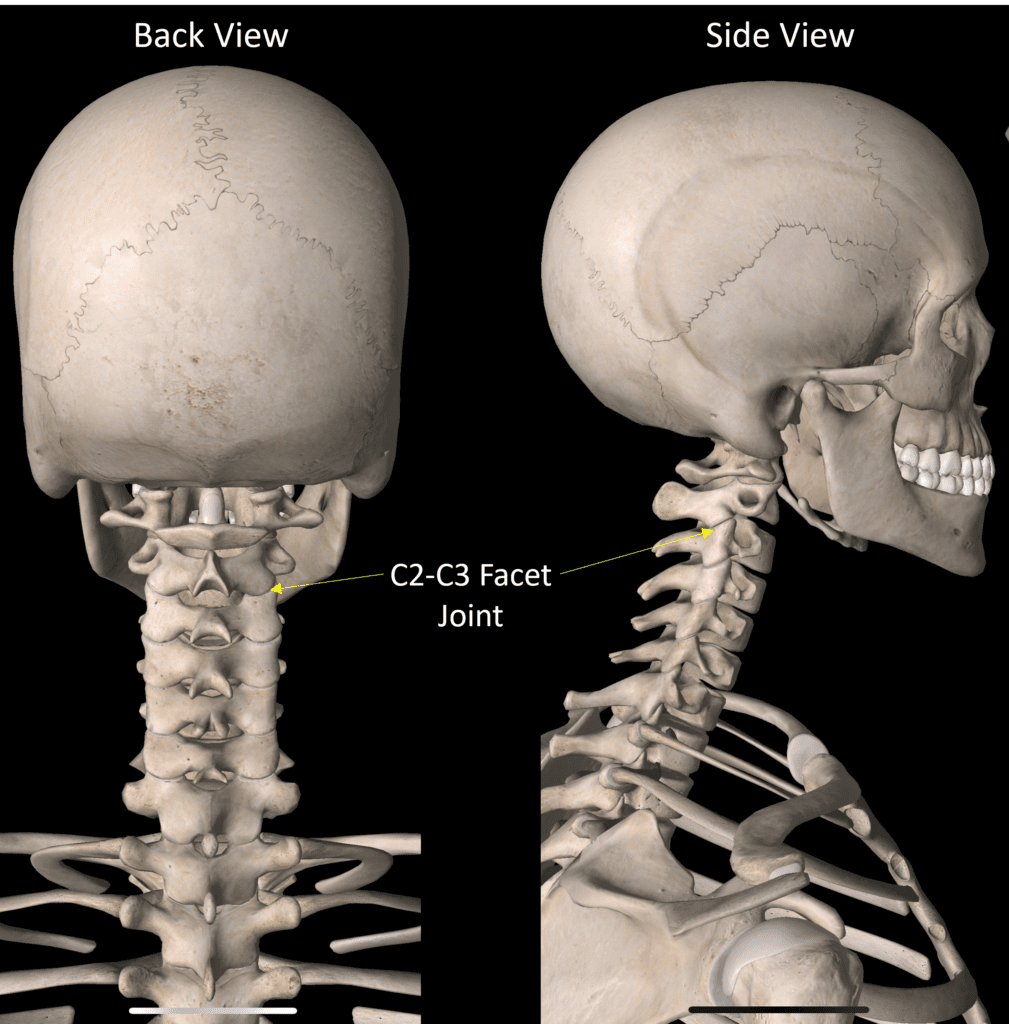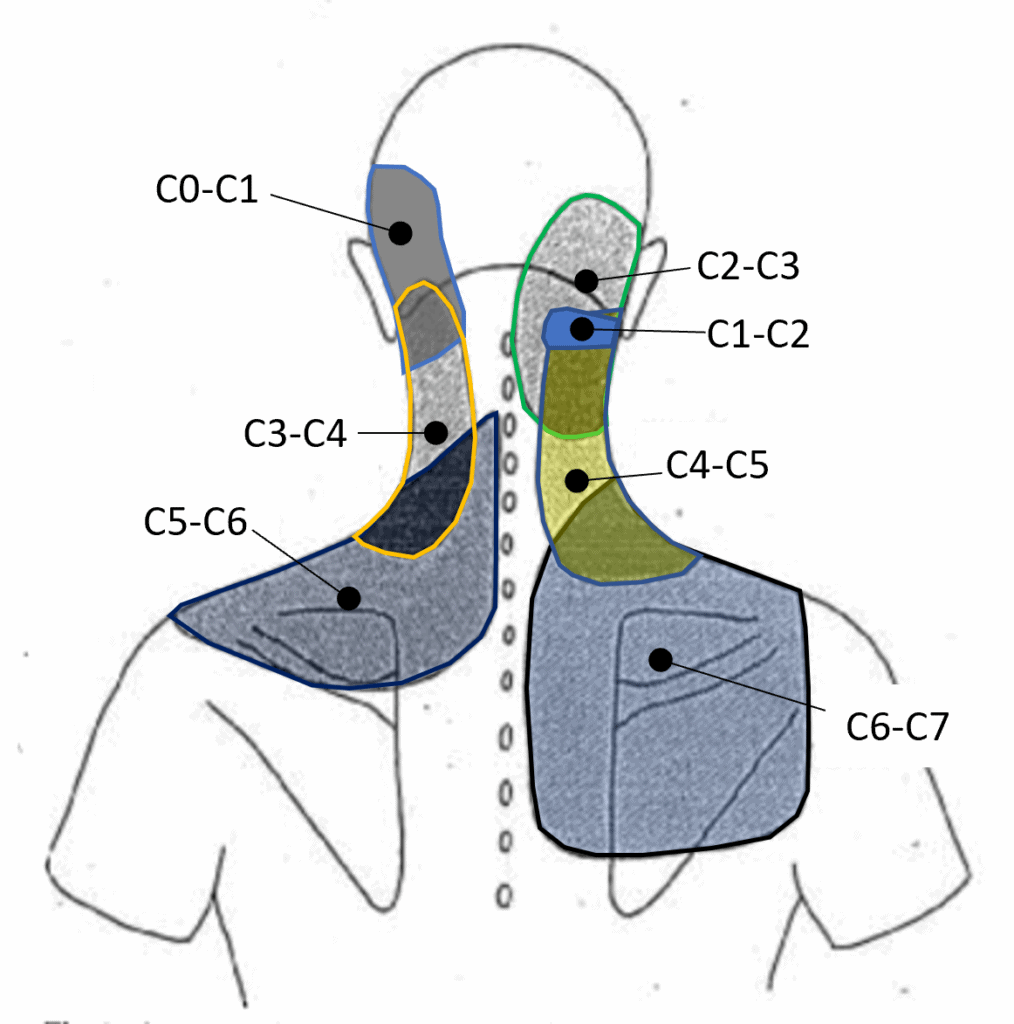What’s the Purpose of a Neck Facet Injection?
These past few weeks I’ve had a number of patients with Neck Instability who are confused as to why we perform Neck Facet injections with Orthobiologics. So today I’ll dive into this topic and try to help everyone get on the same page. Let’s dig in.
What Is a Neck Facet Joint?

Credit: Centeno
Your spine is made up of vertebrae and there are seven of those neck bones in your Cervical spine numbered C1-C7 (the skull is C0). Those bones come together in the back at two joints which live at each level. Those joints are about the size of a finger joint and are officially called Zygoapophyseal joints, but the usual name given to any one of them is a “Facet” Joint. I have shown the C2-C3 Facet joint above which is made up of a part from the C2 vertebra and a part from the C3 vertebra.
Facet Joint Pain

Credit: Heavily modified image by blog author taken from Dwyer et al
Your Neck Facet Joints can become painful either through injury or wear and tear Arthritis. In that way, they’re just like a knee or finger joint. Unlike those joints which get most of their stability from ligaments inside or in the capsule (covering) of the joint, most of the stability for Facet Joints comes from other big ligaments elsewhere in the spine. Like the knee and the finger joints, when there is poor stability, the Facet Joints get more beat up, lose cartilage, and become painful.
Each Neck Facet Joint has a characteristic place it refers to when painful. That means that when that joint is hurting, on exam that Facet will be painful when pressed. In addition, the patient’s pain pattern will be in the areas shown above (1). Those painful areas are an amalgam of the reports of many patients, so everyone experiences the pain in a slightly different place within that zone. Because of that, we can work backward to find which joint to inject. For example:
- Pain in the head usually comes from the C0-C1, C1-C2, or C2-C2 joints
- Pain in the neck: C3-C3, C4-C5
- Pain at upper Trapezius or shoulder blade: C5-C6 or C6-C7
For example, if the patient has headache pain and the C2-C3 joint is tender on exam, then it’s a pretty good bet that the headache is being caused by that joint.
Facet Joint Treatment Approaches
There are two VERY different ways to treat painful Neck Facet joints. The traditional Pain Management and the Orthobiologic approaches. These are summarized below:
- Traditional Pain Management: The goal is to reduce the pain. High dose steroid injection into the joint and/or a medial branch block (diagnostic numbing of the nerve that takes pain from the joint). Both of these procedures, if they only provide short-term relief, usually end in Radiofrequency Ablation (RFA). This is where the nerve that takes pain from the joint is killed off via a thermal probe. These decreased pain effects can last from a few weeks to about a year for RFA.
- Orthobiologic: The goal is to help the damaged joint heal or to reduce ongoing arthritic breakdown by injecting an Orthobiologic agent inside the joint. Usually, Platelet-Rich Plasma is injected, but sometimes Bone Marrow Concentrate (which contains the patient’s own stem cells) is also used. In addition, lax ligaments are also usually injected, as that’s usually the cause of Facet Joint Arthritis.
Hence, Pain Management is what it sounds like, which are procedures to help the pain. The Orthobiologic approach is to try to fix the problem.
What are Orthobiologics? See my video below:
The Facet Injection
This is where you as a patient need to be careful. Many doctors who perform Prolotherapy will tell patients that they are treating their painful Facet joints, but never actually inject the joint. This is because getting into these small joints is difficult and requires more skill, equipment, and training. So what does a real versus a fake Facet joint injection look like?
- Real Facet Joint injection – The use of x-ray guidance (fluoroscopy) to place a needle inside the Facet Joint and then confirming that placement by injecting radiographic contrast. This takes about a year to learn how to do, hence most physicians with this skill set have been through an Interventional Spine Fellowship.
- Fake Facet injections – Placing the needle somewhere in the vicinity of the Neck Facet Joint either blind or with imaging (x-ray or ultrasound), but without using contrast to make sure you’re in the joint.
As you can see, the difference is using radiographic contrast to make sure the stuff you’re injecting will end up inside the joint. For example, while a real Facet Joint injection for an experienced Interventionist may take from 2-10 minutes each because of the need to get an Arthrogram (confirmation you’re in this small joint), a fake Facet Joint injection takes seconds to perform.
Also, be cautious when sourcing providers to inject C1-C2 and C0-C1. These joints are rarely injected by even the most experienced Interventional Spine physicians. Doctors are like everyone else, their skills suffer when they do something infrequently. If on the other hand, they perform a procedure several times a week, they become an expert at that procedure. For these high upper neck joints, 99% of the experienced doctors don’t do these more than a few times a year. This is a real problem as competency comes from performing these procedures dozens to 100+ times a year.
The concern for these two joints stems from the proximity of the Vertebral artery, which supplies blood to the back of the Brain. In experienced hands and the right type of additional software on the Fluoro machine (DSA or Digital Subtraction Angiography), these can be performed safely. On the other hand, in inexperienced hands, direct injection into this artery of the wrong stuff can be a very bad day for everyone.
Confusing Facet Pain and Instability
What I’ve observed these past few weeks is that some of my Neck Instability patients with damaged ligaments are confusing Instability with Facet pain. Remember what is above those painful and arthritic Facet Joints is a consequence of the extra and abnormal spinal motion created by loose ligaments (Instability). Hence, when we treat Facet Joints with Orthobiologics in these patients, it has little to do with stability but is focused on trying to help the beat-up joint repair or reduce the degenerative cascade that comes with Arthritis. That can help their pain in all of the areas discussed above. When we’re focused on treating instability, we’re injecting the big ligaments of the spine. We can also often combine these two approaches (Facet and ligament injections) for a more complete and holistic treatment.
So when a patient comes in and asks that we treat the C0-C1 Facet Joint to help their upper neck stability, you can hopefully now see that this makes no sense. The joint gets beat up and hurts because of loose upper neck ligaments (Alar, Transverse, Accessory, and many others) and isn’t itself a major player in keeping itself stable. Said another way, the joint is the bystander who gets hurt, but the problem (Instability) is caused elsewhere. Now if the joint is painful due to Instability, we can inject it to help that pain. However, that means we’re injecting the downstream consequence of the Instability and without also injecting the major ligaments that stabilize that joint, we’re not treating the cause of the problem.
Conversely, what should we do if the joint doesn’t hurt? Let’s stick with our C0-C1 example. If the patient is seeing an upper cervical chiropractor and feels that when the joint is in place their whole symptom complex is better, we’re likely not dealing with Facet pain, but Instability caused by ligaments that live outside the joint. In this example, let’s say the patient notices that years of headache pain and lots of autonomic symptoms immediately go away when the joint is correctly positioned through adjustment. That means that these symptoms are not coming from a beat-up joint (which would still be beat up even once positioned correctly), but from other things like position sensors in the joint capsule or from other structures that cause headaches (like the occipital nerves) or autonomic symptoms (like the vagus nerve).
The upshot? I hope this blog helps patients to understand the differences between Facet Joint pain and Instability and why we inject the joints versus inject the ligaments. Again, the goal is to educate patients because an educated patient is always one that gets better more quickly!
________________________________________
References:
(1) Dwyer A, Aprill C, Bogduk N. Cervical zygapophyseal joint pain patterns. I: A study in normal volunteers. Spine (Phila Pa 1976). 1990 Jun;15(6):453-7. doi: 10.1097/00007632-199006000-00004. PMID: 2402682.

If you have questions or comments about this blog post, please email us at [email protected]
NOTE: This blog post provides general information to help the reader better understand regenerative medicine, musculoskeletal health, and related subjects. All content provided in this blog, website, or any linked materials, including text, graphics, images, patient profiles, outcomes, and information, are not intended and should not be considered or used as a substitute for medical advice, diagnosis, or treatment. Please always consult with a professional and certified healthcare provider to discuss if a treatment is right for you.